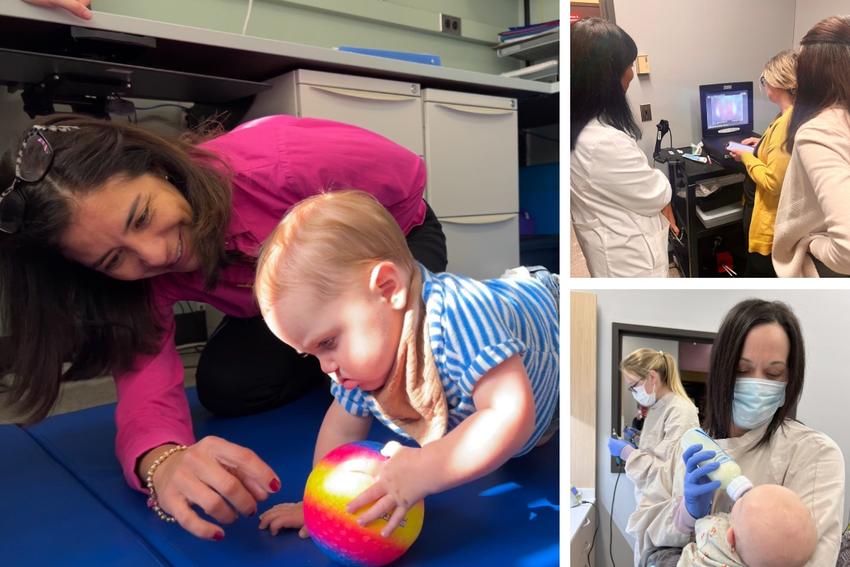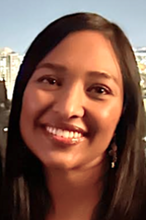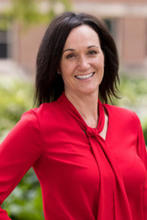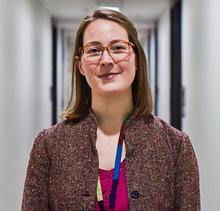Working together for 60 years of compassionate care at the Cleft and Craniofacial Clinic

The Cleft and Craniofacial Clinic at the School of Dentistry is entering its sixth decade with a new director and renewed enthusiasm for interprofessionalism and patient care.
Established in 1964, the Cleft and Craniofacial Clinic specializes in treating children and adults with conditions affecting the head, face and dentition, including cleft palate. The interprofessional team focuses on speech, craniofacial and dental development, facial appearance and quality of life.
New director, new directions in care

Renie Daniel, DMD, MD, FACS, joined the team as director in 2024 with the knowledge that “the clinic has a strong history as one of the first cleft teams in the country.”
“This team is one of the most comprehensive teams I have been part of, in that not only are the core specialties represented, but many other specialists a child with cleft and craniofacial needs may require are easily accessible for referrals,” she explained. The clinic works with nursing, speech-language pathology, audiology, pediatric dentistry, orthodontics, oral and maxillofacial surgery and other specialties to ensure a seamless approach for patients. “This means our patients have access to pediatric dentists, orthodontists and prosthodontists who are leaders in the field of education.”
Daniel, who began as an oral and maxillofacial surgeon before specializing in cleft and craniofacial surgery, is a fierce advocate for her patients, outreach and dental and medical education. “These children are so incredibly resilient, and I am in awe of each one,” she reflected. “Often they have undergone more surgeries, procedures, hospitalizations and testings in the first ten years of their lives than most people do in an entire lifetime. Yet they develop into compassionate, happy and driven young people. They have taught me everything I know about courage. They are my heroes.”
Working as a team improves outcomes
Daniel is most excited about the interprofessional team available at the clinic. “The collegiality and common goal of optimizing our patients’ outcomes among my pediatric colleagues is one of the most rewarding parts of my job.”
And Daniel’s colleagues agree. Mackensie McBeain, DDS, faculty pediatric dentist, advises on dental concerns and is the provider for nasoalveolar molding, a presurgical procedure that improves outcomes leading up to the first lip repair surgery. “I get to form a great bond with these families, as I am seeing them at birth with their nasoalveolar molding and then throughout their childhood until they grow up,” she said. “It’s such a privilege to be able to walk with families through all the steps and procedures and watch the children grow and thrive!”
McBeain agrees that teamwork is the most important aspect of the clinic. “All of us as providers play a unique and important role in the patient’s care, and when we are able to work together, we can provide the patient and their families with the least burden and the best outcome,” she said.

For Karla Olesen, BSN, RN, PHN, LDA, nurse care coordinator, an interdisciplinary team “brings all the necessary specialists directly to our patients and their families, eliminating the need for them to juggle multiple appointments and providers.” That’s particularly important for Olesen, whose role is to “ensure everything runs smoothly and our patients and families feel supported every step of the way.”
“One of our primary missions is to make sure all families have access to team care, which we hope starts as soon as possible after a diagnosis,” Olesen explained.
Kerry Witherell, AuD, CCC-A, FNAP, director of clinical programs in audiology in the Department of Speech Language and Hearing Sciences, has served as the audiologist for the clinic since 2014. “This is a very tight community, and we are lucky enough as providers to be able to be part of each family’s journey year after year,” she explained. “Getting to see these kids grow up and to celebrate their success with them is so rewarding.”

Witherell values the way the school’s clinic can be a “one stop shop for the family’s needs to provide a clear and cohesive plan.” She also supervises the Doctor of Audiology students as they rotate through the clinic, giving them a prime example of what a truly interdisciplinary team looks like and what it means to care for these patients. “I feel so fortunate that these students are able to work with such a special population, but they also get to experience exceptional interdisciplinary team care. I hope they will take that knowledge with them as they become future audiologists.”
For Anna Thurmes, PhD, MA, CCC-SLP, clinical assistant professor of pediatric dentistry and lead speech-language pathologist, this work is very personal. “Having been born with a cleft lip and palate and being a former patient in the clinic, I deeply understand the journey these families are on,” she explained. “The team here empowered my parents, who in turn nurtured my resilience.” Today, Thurmes oversees speech-language and feeding services, trains students and fellows and promotes outreach and education. “Overall, my goal is to contribute to the holistic wellbeing of our patients and their families by ensuring they receive the highest standard of care and support,” she said.
Thurmes takes “immense pride in contributing to these patients’ journey and ensuring optimal outcomes.” She also recognizes the value of working with a team across specialties. “By bringing together specialists from various disciplines, team care ensures timely access to tailored and sequenced care that aligns with each patient’s specific needs and goals,” she said. “This collaborative approach facilitates communication for informed decision making, ultimately improving patient outcomes and enhancing overall quality of life for both patients and families.”
Hope for the future
It can be a frightening thing, finding out that one’s child will be born with a cleft lip or palate or other craniofacial condition. But with a village like the one at the School of Dentistry, care and compassion are available from day one—and Daniel and her team want those parents to know that they’re not alone.
“Cleft lip and palate is a very treatable birth anomaly,” Daniel said. “It is an overwhelming diagnosis to learn, but our team is here to support patients and families at every step of the child’s life, from birth to adulthood. We are on this journey together.”